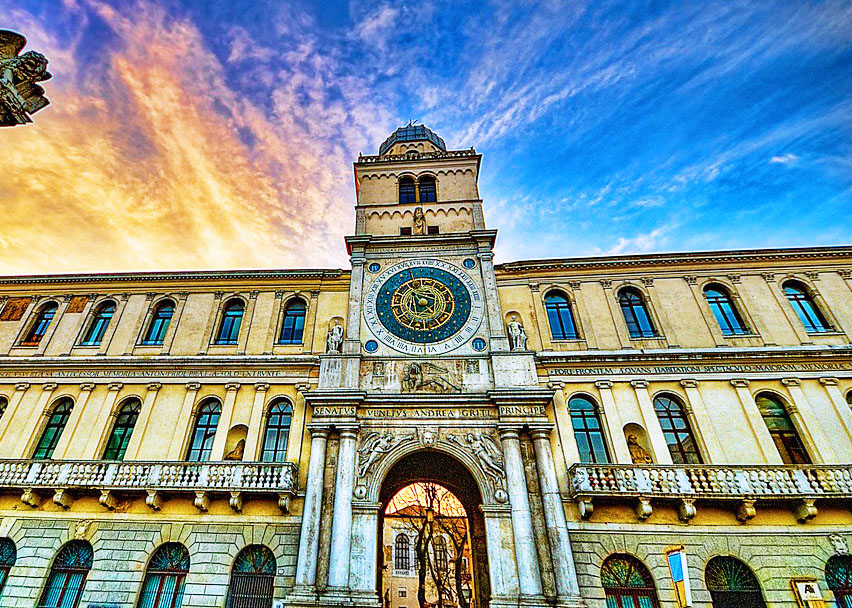In the central area of the Veneto plains, among lagoons, hills and the foothills of the Alps, lies the Province of Padua, a fascinating mixture of artistic treasures, cultures, flavors and traditions. Marvelous is the perfect word to describe Padua – visitors are stunned by its beauty and then marvel at its monuments and are inspired by the Paduans themselves, whose energetic character is veiled behind a casual air of nonchalance. A visit to the province is a discovery of a territory remarkably rich in history, vitality and ingenuity, characterized by a great variety of places to see, products to taste and people to meet.
In the heart of the province is the city of Padua. The province’s dynamic namesake has a vast historical and monumental heritage and is surrounded by significant natural and cultural attractions, including the Euganean Springs and the Euganean Hills, medieval defensive walls and castles, remarkable villas along the Brenta River, as well as series of canals that run east towards the Veneto Lagoon.
The southeast portion of the province is where visitors find the Euganei Hills, a treasure chest of wonders. Green valleys and pretty hills covered in vineyards and olive groves are made even more beautiful by the colors of spring and the warm atmosphere of autumn. The area is endowed with a rich diversity of botanical life, with over 1,400 plant species. The hills enclose the largest thermal area in Europe – the Terme Euganei, internationally-renowned for their therapeutic waters.
The province is also made up of a vast network of navigable waterways. Between Padua and Venice, a cruise along the Brenta River is an absolutely unforgettable experience. The waterway was the thoroughfare of the Venetian aristocracy, as they made their way from Venice to their magnificent summer villas along the river. The palazzos, which date from the 16th and 17th centuries, are works of extraordinary architecture from renowned master such as Preti, Scamozzi and the greatest of all – Palladio. Summer and fall tours on the canals that encircle Padua offer a unique opportunity to view the city from a different perspective.
A tour of the fortified cities is an intriguing way to get to know Padua’s medieval history. Cittadella, Monselice, Este and Montagnana are an ideal way to take a step back in time, through tours of the walled cities and historical re-enactments in period attire. Cittadella, to the north of the capital, is surrounded by strong walls with 32 watchtowers. Not far away is Monselice, where at the highest point in the small town, a majestic fortress built during Emperor Frederick’s dominion towers over the area. At Este’s Carraresi Castle 12 towers medieval trace the route of the exterior walls, but most impressive of all is Montagnana.
Rising from the fertile plain between the Adige River and the Euganean Hills, Montagnana was originally built by the Romans to defend the river area. The town is known for its formidable stone walls, impressive not only for their size and state of preservation, but also for their length, which runs for more than one mile. Four gates lead to the town’s historical center. Here you will find buildings that date back to the 13th century. At one time a moat encircled the exterior of the walls. They have long been filled in and now, covered in grass, create a green frame that runs around the 24 towers, each connected by the wall. At the western gate is the mighty Rocca degli Alberi (Rock of the Trees), a fortification comprised of three main buildings and a 115 foot tall tower. Each September, it is the setting of the Palio dei 10 Comuni del Montagnese, where ten of the towns of the province join together for a spectacular horse race. This year, the festivities take place on Sunday, September 8, with pageantry and processions, followed by the exciting palio. If you are visiting the area during the spring, you may also want to keep in mind that Montagnana is also famous for its delicious Prosciutto Veneto PDO festival that takes place in mid-May. Proving a fine sampling of foods, the event attracts thousands of visitors.
Millions flock to Venice each year – and for good reason, but those whose itinerary only allows for a day in Veneto, should seriously consider revising their plans. The City of Padua is a marvel on countless levels. It is sophisticated and upscale without being pretentious. The city is one of the oldest and most dynamic in Italy. Founded more than 3,000 years ago along a curve of the Brenta River, today it is modern and cosmopolitan, well-known for its history, its glorious University and for the innumerable art masterpieces that are diffused throughout the city.
The best way to see Padua’s historic center is on foot, strolling its porticoed roads, splendid piazzas and ancient bridges. Its piazzas are the perfect departure point, particularly Piazza delle Erbe and Piazza dei Frutti, which for centuries has featured a produce market that is a cross section of daily life and commerce. It makes an ideal venue for people watching as well as socializing.
Overlooking the two piazzas is one of Padua’s several symbolic monuments, Palazzo della Ragione, also referred to as the Salone, which features a series of shops on the ground floor. A short walk away is Piazza dei Signori, an elegant piazza with Renaissance touches, surrounded by famous monuments including the Church of San Clemente, Palazzo del Capitanio and the imposing Tower adorned with its famous 14th century astrological clock. Additionally, nearby is Piazza del Duomo, dominated by the majestic Cathedral and the ancient St. John’s Baptistry, decorated with frescoes by Giusto de’ Menabuoi. Next to the Duomo rises Palazzo Vescovile, the seat of the Diocesan Museum since 2000. Inside it holds magnificent artworks and the impressive Bishops’ Hall.
Another of Padua’s symbols is Caffè Pedrocchi. Built in the early 1800s, it plays host to important cultural exhibits and events and faces Palazzo Bo and the prestigious Università di Padova. The University is the second oldest in Italy is renowned for its science programs. It boasts Galileo Galilei among its esteemed past professors. The university also houses the oldest anatomic theatre in the world and it is open to visitation.
No visit to Padua is complete without taking the time to admire the Scrovegni Chapel, one of Giotto’s masterpieces with frescoes completed in the early 14th century. The small church is adjacent to the Augustinian monastery, the Monastero degli Eremitani, both of which are now part of the complex of the Museo Civico of Padua.
Visitors to Piazza del Santo marvel at Donatello’s equestrian statue dedicated to Gattamelata and are awestruck by the Basilica di Sant’Antonio. The monumental work combines Romanesque, Gothic and Byzantine styles in a harmonic blending, embellished by prestigious paintings and sculptures. In the vicinity is the oldest botanical garden in the world which is a UNESCO World Heritage Site. Founded during the pinnacle of the Venetian Republic, it was conceived as a place dedicated to the study and cultivation of medicinal plants.
The Province of Padua has always been a crossroads of peoples and culture, a land rich in treasures to discover and one that should be included in every Veneto traveler’s itinerary.





